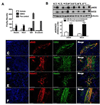Perivascular nitric oxide activates notch signaling and promotes stem-like character in PDGF-induced glioma cells
- PMID: 20144787
- PMCID: PMC3818090
- DOI: 10.1016/j.stem.2010.01.001
Perivascular nitric oxide activates notch signaling and promotes stem-like character in PDGF-induced glioma cells
Abstract
eNOS expression is elevated in human glioblastomas and correlated with increased tumor growth and aggressive character. We investigated the potential role of nitric oxide (NO) activity in the perivascular niche (PVN) using a genetic engineered mouse model of PDGF-induced gliomas. eNOS expression is highly elevated in tumor vascular endothelium adjacent to perivascular glioma cells expressing Nestin, Notch, and the NO receptor, sGC. In addition, the NO/cGMP/PKG pathway drives Notch signaling in PDGF-induced gliomas in vitro, and induces the side population phenotype in primary glioma cell cultures. NO also increases neurosphere forming capacity of PDGF-driven glioma primary cultures, and enhances their tumorigenic capacity in vivo. Loss of NO activity in these tumors suppresses Notch signaling in vivo and prolongs survival of mice. This mechanism is conserved in human PDGFR amplified gliomas. The NO/cGMP/PKG pathway's promotion of stem cell-like character in the tumor PVN may identify therapeutic targets for this subset of gliomas.
Copyright 2010 Elsevier Inc. All rights reserved.
Figures







Comment in
-
NO Signals from the Cancer Stem Cell Niche.Cell Stem Cell. 2010 Feb 5;6(2):97-8. doi: 10.1016/j.stem.2010.01.007. Cell Stem Cell. 2010. PMID: 20144782
Similar articles
-
Essential roles of the nitric oxide (no)/cGMP/protein kinase G type-Iα (PKG-Iα) signaling pathway and the atrial natriuretic peptide (ANP)/cGMP/PKG-Iα autocrine loop in promoting proliferation and cell survival of OP9 bone marrow stromal cells.J Cell Biochem. 2011 Mar;112(3):829-39. doi: 10.1002/jcb.22981. J Cell Biochem. 2011. PMID: 21328456
-
A Tumor Suppressor Function for Notch Signaling in Forebrain Tumor Subtypes.Cancer Cell. 2015 Dec 14;28(6):730-742. doi: 10.1016/j.ccell.2015.10.008. Epub 2015 Dec 5. Cancer Cell. 2015. PMID: 26669487
-
Notch activation promotes cell proliferation and the formation of neural stem cell-like colonies in human glioma cells.Mol Cell Biochem. 2008 Jan;307(1-2):101-8. doi: 10.1007/s11010-007-9589-0. Epub 2007 Sep 12. Mol Cell Biochem. 2008. PMID: 17849174
-
Platelet-derived growth factor in human glioma.Glia. 1995 Nov;15(3):257-63. doi: 10.1002/glia.440150307. Glia. 1995. PMID: 8586462 Review.
-
The functional role of Notch signaling in human gliomas.Neuro Oncol. 2010 Feb;12(2):199-211. doi: 10.1093/neuonc/nop022. Epub 2009 Dec 14. Neuro Oncol. 2010. PMID: 20150387 Free PMC article. Review.
Cited by
-
Optimization of radiation dosing schedules for proneural glioblastoma.J Math Biol. 2016 Apr;72(5):1301-36. doi: 10.1007/s00285-015-0908-x. Epub 2015 Jun 21. J Math Biol. 2016. PMID: 26094055
-
Cleaved NOTCH1 Expression Pattern in Head and Neck Squamous Cell Carcinoma Is Associated with NOTCH1 Mutation, HPV Status, and High-Risk Features.Cancer Prev Res (Phila). 2015 Apr;8(4):287-95. doi: 10.1158/1940-6207.CAPR-14-0366. Epub 2015 Jan 29. Cancer Prev Res (Phila). 2015. PMID: 25633867 Free PMC article.
-
The three-layer concentric model of glioblastoma: cancer stem cells, microenvironmental regulation, and therapeutic implications.ScientificWorldJournal. 2011;11:1829-41. doi: 10.1100/2011/736480. Epub 2011 Oct 23. ScientificWorldJournal. 2011. PMID: 22125441 Free PMC article. Review.
-
CDH5 is specifically activated in glioblastoma stemlike cells and contributes to vasculogenic mimicry induced by hypoxia.Neuro Oncol. 2013 Jul;15(7):865-79. doi: 10.1093/neuonc/not029. Epub 2013 May 3. Neuro Oncol. 2013. PMID: 23645533 Free PMC article.
-
ABCG2 regulates self-renewal and stem cell marker expression but not tumorigenicity or radiation resistance of glioma cells.Sci Rep. 2016 Jul 26;6:25956. doi: 10.1038/srep25956. Sci Rep. 2016. PMID: 27456282 Free PMC article.
References
-
- Bakshi A, Nag TC, Wadhwa S, Mahapatra AK, Sarkar C. The expression of nitric oxide synthases in human brain tumours and peritumoral areas. J Neurol Sci. 1998;155(2):196–203. - PubMed
-
- Becher OJ, Hambardzumyan D, Fomchenko EI, Momota H, Mainwaring L, Bleau AM, Katz AM, Edgar M, Kenney AM, Cordon-Cardo C, et al. Gli activity correlates with tumor grade in platelet-derived growth factor-induced gliomas. Cancer Res. 2008;68(7):2241–2249. - PubMed
-
- Bender AT, Beavo JA. Cyclic nucleotide phosphodiesterases: molecular regulation to clinical use. Pharmacol Rev. 2006;58(3):488–520. - PubMed
-
- Blaise GA, Gauvin D, Gangal M, Authier S. Nitric oxide, cell signaling and cell death. Toxicology. 2005;208(2):177–192. - PubMed
Publication types
MeSH terms
Substances
Grants and funding
LinkOut - more resources
Full Text Sources
Molecular Biology Databases
Miscellaneous

